by Matt | Mar 3, 2015 | Drinking Water Quality, Global Water Crisis, water quality
by Jennifer D. Olsen
The Global Burden
On the outskirts of Bethlehem, in the West Bank, sits Aida refugee camp. Established in 1950, this camp began as an informal settlement for Palestinian families displaced by conflict. Sixty-five years later, the nearly 5,000 refugees living there are surviving on stopgap water and sanitation infrastructure. Water does not flow freely and during the summer months, it often does not flow at all. During the summer, contaminated water is a looming concern for the people here. Water that sits, stagnant, in the pipelines and cisterns has a greater risk of contamination, and consequently, a greater risk of illness for those who drink it.
In an otherwise different part of the world, women and children approach a community water pump in the mountainous country of Rwanda. The water pump has broken, and to use it leads to contamination and further disrepair. Families will instead spend hours collecting dirty water from puddles, streams and swamps. In no way dissimilar to other villages in this country, piped water is not a guarantee. No matter how it comes, water is not well regulated, if at all. Waste accumulation, poor resources, and limited governmental capacity all contribute to a suffering water quality, and in turn, a suffering population.

Contaminated water is a real concern for these communities, as diarrheal disease, an outcome of poor water quality, kills an estimated 2,300 people per day globally. According to the World Health Organization, a child dies from a water-related illness every single minute. These statistics, though scary in their sheer magnitude, bring perspective to the global water burden. 750 million people in the world (approximately 1 in 9 people) lack access to safe water. That’s more than two times the entire population of the United States.
Here in the U.S., we have some of the cleanest water in the world. And yet, most of us don’t drink it. We are the largest consumer of bottled water in the world, and sales have been resolutely rising for over three decades. It makes the rational consumer wonder, why buy water?
The Domestic Paradox
In the U.S., our water is safe and highly regulated. Drinking water is monitored by the Environmental Protection Agency, which sets regulations on safe contaminant levels. The U.S. Public Health Service established fluoridation of the public water supply over fifty years ago and is considered by the CDC as one of the ten greatest public health achievements of the 20th century. Water and waste management systems have also been evolving concurrently to manage the swelling populations of our top cities.
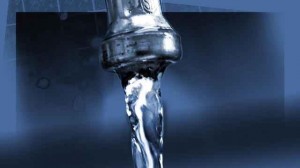
Boston’s own Deer Island is home to the revolutionary Massachusetts Water Resources Authority (MWRA), whose world-renown facilities provide resources to over 2.2 million people in the metropolitan Boston area. The MWRA reports annually on the region’s water, the results of which are distributed to residents and available online for viewing. Monthly reports are also available. The American Water Works Association, a nonprofit dedicated to managing and treating water, recently declared the MWRA’s water to be the second best tasting water in the entire country. You might be thinking, if the MWRA is number two, who has the number one best tasting water? That would be our very own Boston Water and Sewer Commission. Suffice to say, you cannot go wrong with local water.
Look Beyond the Marketing
So now that we know how good our tap water is, why do we buy? The bottled water industry has exploded since the 1990s, and continues to grow as we are inculcated with propaganda that bottled water is cleaner, healthier, and more delicious than the nearly free water from our tap.
However, numerous studies have shown that tap water and bottled water are nearly identical in quality, with half of all bottled water being actually identical, as many large companies get it directly from the public supply. Additionally, bottled water regulations are less strict than tap water regulations and have the potential for more quality discrepancies. Fluoride, for example, is not mandated in bottled water, proposing an increased risk of dental cavities for the dedicated bottled consumer.
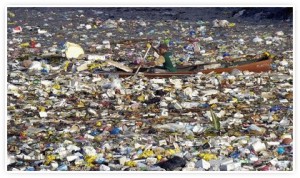
Another obvious downside of bottled water is cost. Americans spent $11.8 billion on bottled water in 2012, which is estimated modestly at 300 times or startlingly at 10,000 times, the cost of tap water. Thinking like a snow-sodden New Englander, if the modest consumer switched from plastic to tap for one year, they could save enough money for a two-week trip to tropical Puerto Rico, and in the winter of 2015, that is priceless.
The waste associated with bottled water is dramatic and extends not just to our own environment, but the environments of countries whose water is not nearly as drinkable as ours. Research studying plastic pollution has found that plastic waste finds its way to the ocean, accumulates in ocean currents, and spreads around the world. Plastic water bottles, caps, rings and fragments from the east coast of the US can be reliably tracked into the ocean currents, where they add to the trash accumulation on the shores of far-off countries, or pollute marine life in the vast open seas. A single plastic bottle can have a life span of 1,000 years, adding to the pervasive global burden of waste.
Go Local
One of the biggest arguments for bottled water consumption is convenience. You’re out, you can’t fill up a cup from your sink, so what else are you going to do to stay hydrated? Where can you get a drink without buying into plastic? Well, luckily for Boston, BeCause Water is addressing this problem with the Drop In App. This app, downloadable on your phone, identifies free sources of local water all around the city. Whether you’re out for a run during the hot summer months or, more likely, lost in a frozen snow tundra, this app identifies businesses and shops that are happy to invest in a smaller bottle footprint by offering you free, clean, and delicious water.
So when it comes to drinking water, go local. We have the capacity and the standards to ensure safe, high quality basic needs, a battle that is still waging in much of the world. We should aim to decrease our plastic bottle footprint, and support the local systems that ensure our health and safety each day. By decreasing our consumption of plastic bottles locally, we can help lighten the global burden of water, waste, and disease.
by Matt | Mar 2, 2015 | water conservation, water efficiency
by Dana Guth
College students are constantly flooded with food, drink, and electricity, pushing the concept of environmental conservation to the back burner. This open tap of resources available to us proves problematic when it finally shuts off. The residents in my dorm learned this the hard way when our hall ran out of hot water. Water conservation truly became a lifestyle. Everyone was forced to master the art of the “in-and-out” shower – and it was one of the best environmental wake up calls we could have received.
This is because, as many of us already know, nothing about your shower is “free.” A typical showerhead spews between 2-5 gallons/minute, so that 20-minute shower is sending around 60 gallons down the drain every day. According to Pays To Live Green, shaving off just 5 minutes can save $0.025 per shower — that’s over 4,500 gallons per year. Check out their shower calculator to find out how much water you’re wasting.
College students are not aware of the full cost of water because they don’t see a single water bill during their stay in their dorm. But it’s cold here in Boston and, in the recent absence of hot water on campus, we certainly started to value this precious resource more. Here are 5 simple shower strategies my suitemates and I have adopted to conserve water:
1) Lessen water pressure
Most dorms won’t allow residents to install low-flow shower heads, but there are other ways to slow down the pressure. Keep the flow on its lowest setting by only partially turning on the water while it heats up. This reduces waste whenever pressure isn’t actually needed.

2) Create a shower playlist
Put together 3-4 songs that add up to around 10 minutes. This helps to stay on track and be mindful of the passing time. Challenge yourself to finish your shower before the end of the playlist. When you achieve that goal, cut the playlist down by a song!
3) Combine shampoo + conditioner
There are plenty of quality shampoo/conditioner fusions on the market that are sure to shave off a few minutes in the shower. If you can’t forgo one or the other, try swapping in a combo just once or twice per week. (Phasing out shampoo can also train your hair to slow down its oil production: read more here)
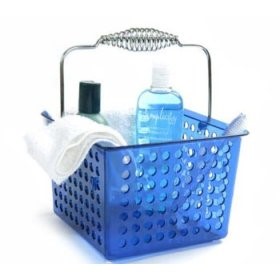
4) Take a break to shave
As you shower, place a bucket under the stream to collect soap and hot water. Then, when it’s time to shave, turn it off until you’re ready to rinse – using the water you’ve collected instead of the showerhead. This prevents the draining of 5 minutes (or more)’s worth of water for those who shave large portions of their body. Plus, it facilitates a way faster process in the cold!
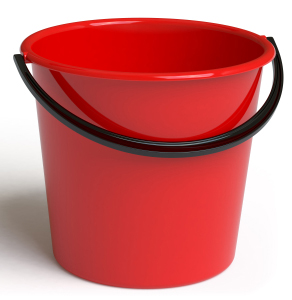
5) Try out the “staggered” shower
Also called the “navy” or “sea” shower, the “staggered” shower is an efficient water conservation strategy: take the bucket idea from #4, but apply it to shampooing, conditioning, shaving, and lathering.It might sound extreme, but turning off running water when you don’t need to rinse is no doubt the most effective way to save energy.
Showering accounts for 17% of our residential water use on college campuses, so it’s vital not to think of your shower as a limitless indulgence. Be mindful of the time spent under the tap and remember: just 1-2 minutes less in a day can save hundreds of gallons a year.
by Matt | Jan 30, 2015 | New Year's Resolutions, water and health
How to Add ‘Water’ to Your New Year’s Resolutions
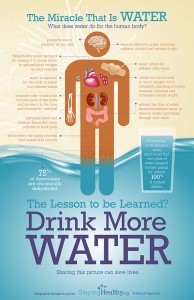
Every year, January brings a long list of New Year’s Resolutions to lose weight, eat right, and lead a healthier lifestyle. Despite these goals to eat more fruits and vegetables, go to the gym, and take the stairs, there is one key health aspect that is often forgotten: water.
Clean water is an essential part of a healthy lifestyle, yet it is something many of us in the United States take for granted. Over 780 million people around the world do not have access to clean water, but US residents have abundant access to clean municipal water. (UN Facts and Figures). The Centers for Disease Control and Prevention (CDC) explains that water is essential for keeping body temperatures normal, lubricating joints, protecting the spinal cord, and getting rid of waste. Despite these benefits, up to 75 percent of Americans may be chronically dehydrated (CBS Miami).
To make 2015 a successful one, let’s prioritize water in our New Year’s Resolutions. This year, aim to conserve and consume water sustainably for a better planet and a healthier YOU. Stuck on the perfect water-related New Year’s Resolution? Here are some perfect ways to incorporate water sustainability into your every day.
1. Your Home
Everyone has a barrier that prevents them from drinking enough water in their home. Overcome those barriers by preventing them in the first place!
- If your tap water’s taste is unappealing, try a Brita pitcher or faucet filter that minimizes the taste of chlorine and can remove impurities such as heavy metals.
- Designate a specific cup, mug, or reusable bottle for water. Keep it filled and carry it with you throughout your home as a reminder to drink more water.
- Drink water at key times throughout the day. To keep hydrated, space out your water consumption and pair with daily activities. For example, set a goal to drink a glass of water when you wake up, at breakfast, at lunch, at dinner, and before bed. That’s already 5 glasses of water! The general rule of thumb is to drink 8 glasses per day (Mayo Clinic).
2. On the Go
We’ve all been there before: We’re in the car or at a meeting, and all we can think about is how thirsty we are. Thirst is a sign that our body is craving water to complete cellular tasks that keep us healthy. Prevent dehydration on-the-go this year.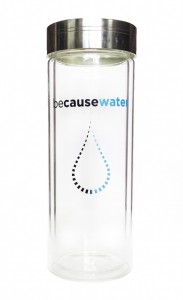
- The best way to keep your body hydrated is to carry a reusable water bottle with you. Having the bottle near you – on your desk, or in your backpack – can remind you to keep drinking water throughout the day.
- Reusable water bottles are easy to refill at a tap or filtered water station. Plus, you can choose a design that fits your personality. BeCause Water has a line of reusable water bottles that keep your filtered water fresh all day long. If you’re looking for a bottle that can filter tap water, try brands like Brita or Camelbak.
- A reusable water bottle is key to a healthy environment and a healthier lifestyle. The majority of plastic disposable water bottles end up in landfills and in the ocean. These plastics create an unhealthy environment for all life on Earth. Do your part and resolve to use a reusable water bottle to carry water with you all year long!
3. School/Workplace
When you’re sitting at your desk, either at work or in class, it’s easy to forget to drink water. Water is essential for keeping our minds and bodies energized. Here are tips for keeping hydrated throughout your day at work or school.
- Keep a water glass, mug, or other container at your desk or in your locker so you can fill up and quench your thirst throughout the day.
- Track your daily water consumption. You’d be surprised at how much better you feel on the days you drink 8 glasses of water. Make a note in your daily planner or use a phone app to tally water intake. Not your style? Try water bottles that monitor your water consumption either digitally or manually.
Make sure to make water a priority in 2015 for improved health and a clean environment! If water quality is an issue in your community, take further action by contacting your local and state representatives to show them that water is important to you.
Good luck with your water-related New Year’s Resolutions! Here’s to 2015.
Have additional ways to incorporate water sustainability into the every day? Leave a comment below!
by Matt | Oct 13, 2014 | Uncategorized
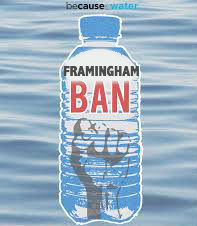 While most high school seniors are currently focusing on filling out college applications and getting their last sports seasons in before graduation, Framingham student Matt D’Amico is fitting a much larger fight into his busy schedule: banning bottled water.
While most high school seniors are currently focusing on filling out college applications and getting their last sports seasons in before graduation, Framingham student Matt D’Amico is fitting a much larger fight into his busy schedule: banning bottled water.
“Seeing what we put into our bodies and how it’s affecting us has always been very interesting for me,” D’Amico said in an interview on Thursday. He felt it was his duty to find a solution, any solution, to see less people suffer from ill health caused by a lack of environmental safety.
“[Eradicating bottled water] was one thing that we could do that wouldn’t really hurt business or consumers so much. It’s really a redundancy that we have considering tap water exists. It’s one of the easiest things to start with”, D’Amico explained.
The Proper Fight
With the negative health effects of ingesting PET (polyethylene terephthalate), the chemical used to make single-serving, single-use plastic water bottles, combined with the immense pollution caused by these bottles, this felt like the proper fight for D’Amico to take on. “The two biggest issues for me are climate change and environmental safety. These bottles simply use up a lot of our natural resources — water, oil — but also destroy the environment in the process.”
D’Amico breaks down the argument against bottled water into three main sections: environmental, health and economic. From an environmental standpoint, he said, the amount of natural resources used in making single-use plastic bottles is astounding. Filling our landfills, rivers and forests with these bottles is causing an environmental safety hazard, one that not only harms the natural world itself, but the humans that reside within it. The negative health effects of PET offer a strong argument on the health side, while the insane economic cost of purchasing these bottles for mere convenience (instead of using free tap water) is also powerful.
The Right Audience
Once D’Amico has a chance to explain his reasoning, most Framingham residents he has spoken with are easily on board with the bottled water ban. “After hearing the arguments,” D’Amico says, “most people agree with it. It’s just getting the word out there and speaking directly to those committee members that will make a difference.”
If successful, the bottled water ban would go into effect in January of 2016, giving businesses plenty of time to rid their shelves of bottled H2O. Luckily, Framingham has a fairly strong water infrastructure to adapt to these changes. Public fountains are fairly abundant in the town. This will also provide the town incentive to invest in more Water Bottle Filling Stations.
The Next Steps
In order to pass the bill, the next few weeks will be packed with meetings, solid debates and a plethora of persuasive emails for the high school senior and his small team. The deciding town meeting vote will occur on October 21st. A simple majority is needed to pass the bill and would make Framingham the second town in Massachusetts to pass a bottled water ban. Concord, MA passed a similar bill in April of 2012.
“I think there’s a good chance this is going to happen,” D’Amico optimistically stated.
Matt mentioned that anyone looking to get involved can email him at framinghamgreeninitiative@gmail.com.
Vote for Matt’s cause to install bottle filling stations in Framingham HERE.
by Matt | Aug 18, 2014 | Global Water Crisis
Women’s Winners
1. Anna Kvaitchadze 24:07.496
2. Shannon Katzmayr 25:52.545
Men’s Winners
1. John Wichers 20:05:609
2. Jay Doubman 22.02:897
Overall
1. John Wichers 20:05:609
2. Jay Doubman 22.02:897
3. Kenneth Holman 22:40:888
4. Michael Gulick 23:20.275
5. Anna Kvaitchadze 24:07.496
6. Mikhail Kacherovich 25:12.958
7. Shannon Katzmayr 25:52.545
8. William Varrell 26:39.197
9. Chris Yuskaitis 26:49.060
10. Jessica Strong 27:39.940
11. Naomi Baver 28:25.854
12. Katie Bolin 28:26.602
13. Colin Barry 8:38.576
14. Ryan Victor 28:38.920
15. Morgan Panzenhagen 28:46.034
16. Greg McGee 29:16.739
17. Maggie Doubman 29:16:924
18. Vicky Hong 29:30.176
19. N/A 30:01.833
20. Melaney Bouthillette 30:13.363
21. N/A 30.23:518
22. Ryan Sutliff 30:30.288
23. Tim Doyle 30:41.489
24. N/A 30:45.836
25. Erica Sigal 32.34.056
26. Colette Biro 32:59.465
27. Eric Pince 33:09.152
28. N/A 33:26.001
29. Sunny Dzik 33:59.080
30. Alexandra Tilden 33:59.869
31. Barbara Grandberg 34:15.441
32. Van Du 34:56.824
33. N/A 35:58.107
34. Caroline Margolis 36:06.001
35. Mike Rheaume 36:22.011
36. Carrisa Burton 36:36.119
37. N/A 36:43.420
38. Steve Sutliff 36:46.364
39. Brendon Sutliff 36:56.837
40. Erin Yuskaitis 37:36.569
41. Carol Pepin 38:03.728
42. Heidi Simons 38:21.228
43. Yaruuna Enkhbold 38:40.338
44. Candice Millionis 40:26.713
45. Henry Needham 40:35.520
46. Demetri Apodiakos 41:33.041
47. Stephanie Sutliff 41:57.531
48. Robert Steeves 42:06.676
49. Yaoming He 42:07.610
50. Christine Goodin 42:13.719
51. N/A 42:36.750
52. Regina Gorenshteyn 42:49.891
53. N/A 43:28.247
54. Steve Borbee 44:50.847
55. Geri Barrison 46:31.361
56. Jocelyn Fish 47:20.914
57. Jill Ralston 48:26.676
58. Liz Bowen 51:49.104
59. Daniel Landry 52:52.549
60. Frank Hughes 53:18.251
61. Mallory Hughes 54:02.666
62. Peter Thomas 1:07:01.542
63. Anita Thomas 1:07:02.684
64. N/A
65. N/A
66. N/A
67. N/A
68. N/A
69. N/A
70. N/A
71. N/A
72. N/A
73. N/A
74. N/A
75. N/A










